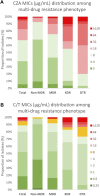Role of the multi-drug efflux systems on the baseline susceptibility to ceftazidime/avibactam and ceftolozane/tazobactam in clinical isolates of non-carbapenemase-producing carbapenem-resistant Pseudomonas aeruginosa
- PMID: 36263116
- PMCID: PMC9574371
- DOI: 10.3389/fphar.2022.1007162
Role of the multi-drug efflux systems on the baseline susceptibility to ceftazidime/avibactam and ceftolozane/tazobactam in clinical isolates of non-carbapenemase-producing carbapenem-resistant Pseudomonas aeruginosa
Abstract
Carbapenem-resistant Pseudomonas aeruginosa (CRPA) is one of the pathogens that urgently needs new drugs and new alternatives for its control. The primary strategy to combat this bacterium is combining treatments of beta-lactam with a beta-lactamase inhibitor. The most used combinations against P. aeruginosa are ceftazidime/avibactam (CZA) and ceftolozane/tazobactam (C/T). Although mechanisms leading to CZA and C/T resistance have already been described, among which are the resistance-nodulation-division (RND) efflux pumps, the role that these extrusion systems may play in CZA, and C/T baseline susceptibility of clinical isolates remains unknown. For this purpose, 161 isolates of non-carbapenemase-producing (Non-CP) CRPA were selected, and susceptibility tests to CZA and C/T were performed in the presence and absence of the RND efflux pumps inhibitor, Phenylalanine-arginine β-naphthylamide (PAβN). In the absence of PAβN, C/T showed markedly higher activity against Non-CP-CRPA isolates than observed for CZA. These results were even more evident in isolates classified as extremely-drug resistant (XDR) or with difficult-to-treat resistance (DTR), where CZA decreased its activity up to 55.2% and 20.0%, respectively, whereas C/T did it up to 82.8% (XDR), and 73.3% (DTR). The presence of PAβN showed an increase in both CZA (37.6%) and C/T (44.6%) activity, and 25.5% of Non-CP-CRPA isolates increased their susceptibility to these two combined antibiotics. However, statistical analysis showed that only the C/T susceptibility of Non-CP-CRPA isolates was significantly increased. Although the contribution of RND activity to CZA and C/T baseline susceptibility was generally low (two-fold decrease of minimal inhibitory concentrations [MIC]), a more evident contribution was observed in a non-minor proportion of the Non-CP-CRPA isolates affected by PAβN [CZA: 25.4% (15/59); C/T: 30% (21/70)]. These isolates presented significantly higher MIC values for C/T. Therefore, we conclude that RND efflux pumps are participating in the phenomenon of baseline susceptibility to CZA and, even more, to C/T. However, the genomic diversity of clinical isolates is so great that deeper analyzes are necessary to determine which elements are directly involved in this phenomenon.
Keywords: RND efflux pump; baseline susceptibility; carbapenem resistant Pseudomonas aeruginosa; cefotolozane/tazobactam; ceftazidime/avibactam.
Copyright © 2022 Contreras-Gómez, Martinez, Rivas, Riquelme-Neira, Ugalde, Wozniak, García, Munita, Olivares-Pacheco and Alcalde-Rico.
Conflict of interest statement
The authors declare that the research was conducted in the absence of any commercial or financial relationships that could be construed as a potential conflict of interest.
Figures



References
-
- Adamson D. H., Krikstopaityte V., Coote P. J. (2015). Enhanced efficacy of putative efflux pump inhibitor/antibiotic combination treatments versus MDR strains of Pseudomonas aeruginosa in a Galleria mellonella in vivo infection model. J. Antimicrob. Chemother. 70 (8), 2271–2278. 10.1093/jac/dkv111 - DOI - PubMed
-
- Arca-Suarez J., Lasarte-Monterrubio C., Rodino-Janeiro B. K., Cabot G., Vazquez-Ucha J. C., Rodriguez-Iglesias M., et al. (2021). Molecular mechanisms driving the in vivo development of OXA-10-mediated resistance to ceftolozane/tazobactam and ceftazidime/avibactam during treatment of XDR Pseudomonas aeruginosa infections. J. Antimicrob. Chemother. 76 (1), 91–100. 10.1093/jac/dkaa396 - DOI - PubMed
-
- Arca-Suarez J., Vazquez-Ucha J. C., Fraile-Ribot P. A., Lence E., Cabot G., Martinez-Guitian M., et al. (2020). Molecular and biochemical insights into the in vivo evolution of AmpC-mediated resistance to ceftolozane/tazobactam during treatment of an MDR Pseudomonas aeruginosa infection. J. Antimicrob. Chemother. 75, 3209–3217. 10.1093/jac/dkaa291 - DOI - PubMed
LinkOut - more resources
Full Text Sources
Miscellaneous

